Ireland and the Somme: How a battle united an island divided
- Published
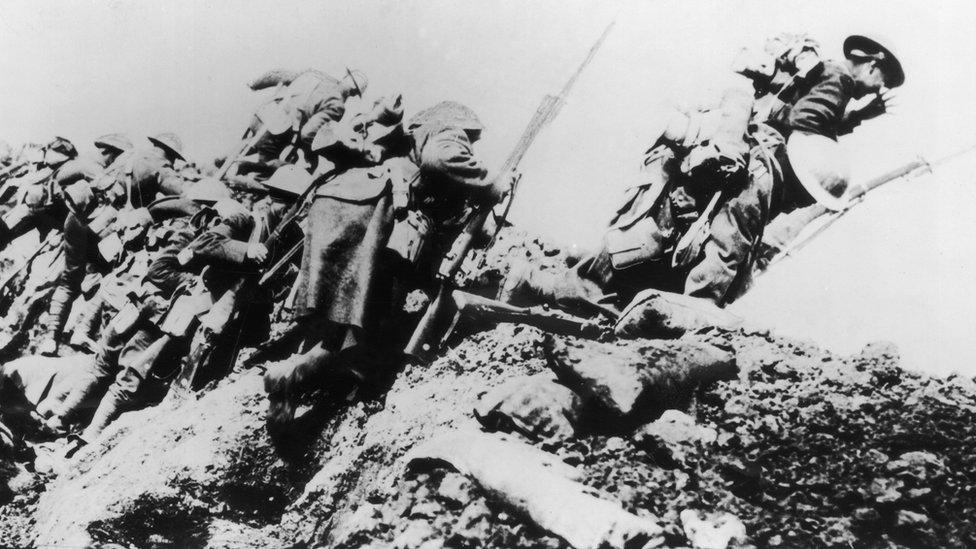
British troops climbing from their trench on the first day of the Somme
When Allied soldiers emerged from their trenches near the Somme river on 1 July 1916, they did so into bright sunshine.
It was supposed to be straightforward. A week-long barrage from 3,000 Allied artillery units had landed three million shells on the German lines.
The theory was that the Germans would have fled or been killed, the barbed wire cut. All the Allies had to do was walk across no-man's land and take the enemy's trenches.
That was the theory. But the wire hadn't been cut, the Germans hadn't been killed and the trenches were most certainly not empty.
The men clambering into the breach were met with a hail of bombs and bullets.
A battle began which would drag on for 141 days; a battle which cost around a million lives by its end; a battle which would be etched into the collective memory of Britain. And Ireland.
A series of special reports looking at the events of the Battle of the Somme and commemorations on its centenary
Fighting Irish
The Irish were well represented in the melting pot of nationalities in the Allied trenches.
They came from an island which, by the time the First World War began in August 1914, was on the brink of civil war.
The crisis in Ireland was brought about by the possibility of Home Rule - something favoured by the Catholic, nationalist southern part of the island; but resisted in the Protestant, unionist north.
The Ulster Volunteer Force (UVF) had been formed in 1913 to stop Home Rule.
The nationalist Irish Volunteers formed in reaction.
Both sides had landed German-made Mauser rifles in preparation for a showdown which never came.
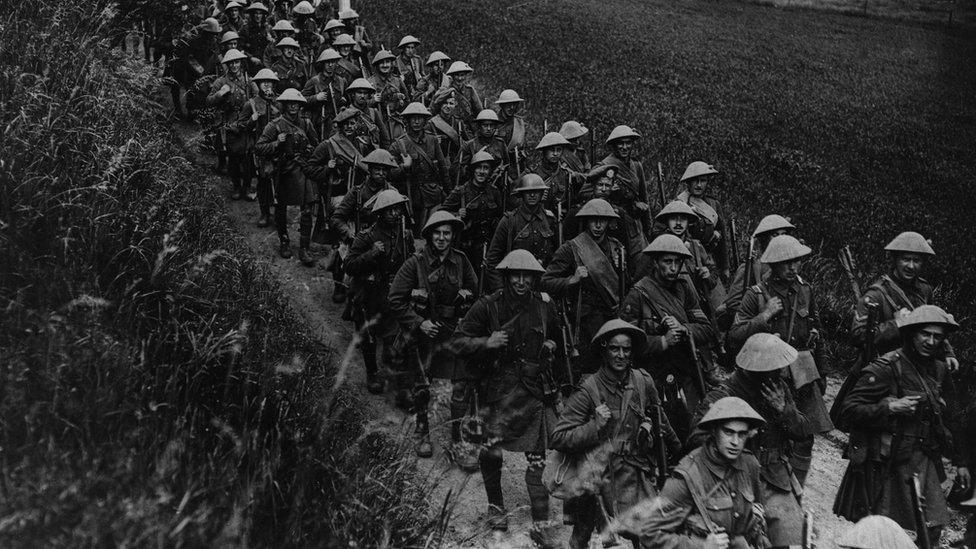
Most of the British troops at the Battle of the Somme had not seen much action and were in good spirits as they were moved to the front line
Outbreak
On 28 June 1914, a young nationalist of a different kind - a Bosnian - fired the shots which would start a world war.
In Sarajevo, Gavrilo Princip assassinated the Austro-Hungarian heir Archduke Franz Ferdinand and his wife.
Europe slid towards war. A war which would put pause to the Irish Home Rule crisis.
Britain knew it needed more men for the campaign. The Secretary of State for War, Lord Kitchener, appealed to civilian men to heed the call.
Ireland responded.
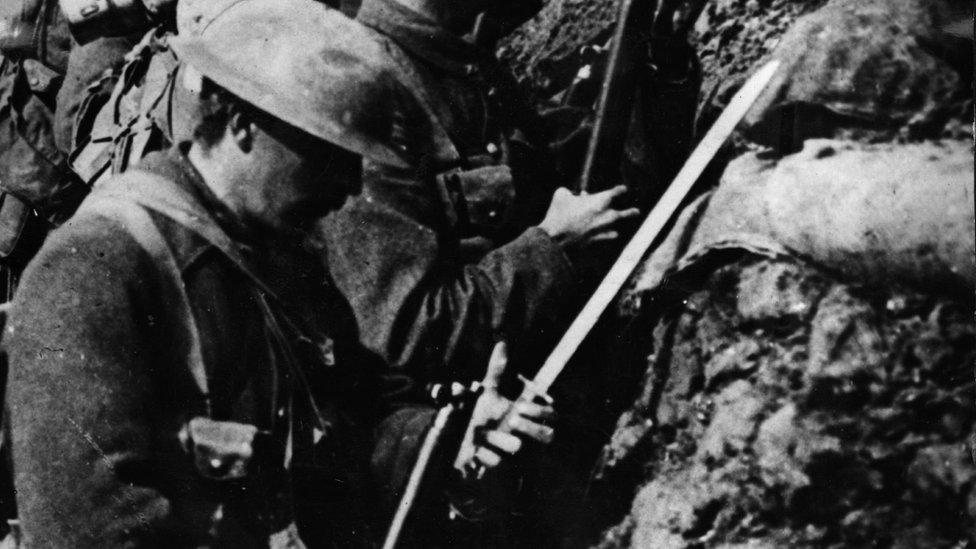
Troops prepare for the charge over the top on 1 July 1916 at the Battle of the Somme
Volunteers
The unionist leader and MP Edward Carson sought assurances that the Home Rule bill would be suspended for the duration of the war before he would commit the UVF to the fray.
He got those assurances, and the Ulster Volunteers formed the basis of an entire division, which became the 36th Ulster Division.
Nationalism, too, answered the call.
Irish Parliamentary Party leader John Redmond urged Irishmen to join up. The reward for loyal service would be Home Rule after the war.
Thousands did join. But others did not and would go on to play a part in the Easter Rising of 1916, a failed military strike against British rule.
It was in this context that Irishmen - Protestant and Catholic, unionist and nationalist - found themselves in trenches stretching across northern France.
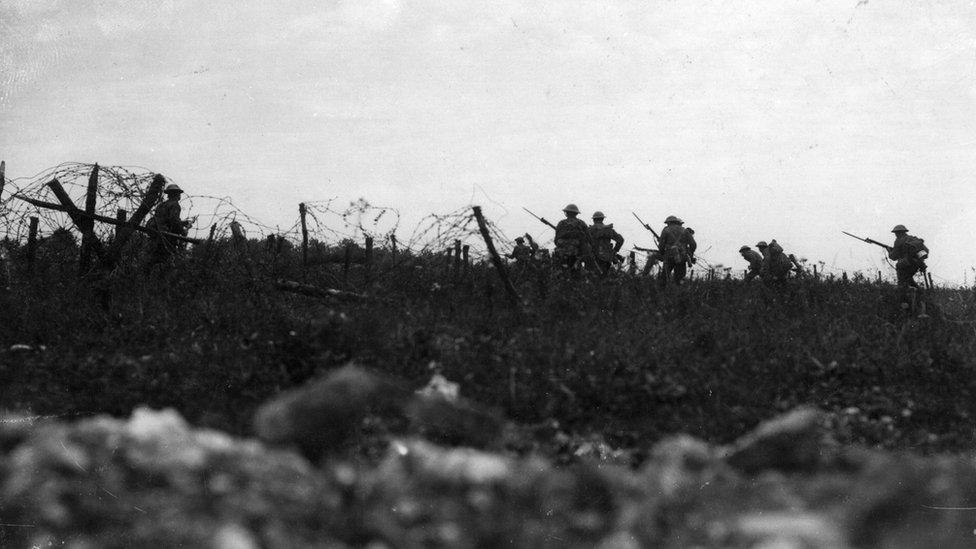
Soldiers advance towards Thiepval at the Battle of the Somme
36th Ulster Division
The 'blood sacrifice' of the 36th Ulster Division was made on the first day of the Battle of the Somme.
On 1 July 1916, its target was the Schwaben Redoubt - a fortified stronghold on the German line near the village of Thiepval.
It was one of the few British divisions to attain its objective that day, much to the surprise of the defending Germans.
The achievement of the inexperienced Ulstermen was remarkable. A slog uphill, across a thousand yards, towards machine gun nests and the determined riflemen of the German army.
Their success came with horrific losses. By the end of the day the division had suffered more than 5,000 casualties, around 2,000 of whom lay dead.
By mid afternoon on 1 July, the soldiers of the 36th found themselves fighting on three sides and were driven back to their starting position late in the day.
The Irish contingent facing German guns on the first day of the battle was not just made up of Ulstermen. The men of the Royal Dublin Fusiliers were there too.

A British soldier looks out over the front line from a trench
16th Irish Division
The main offensive by Irish nationalist troops during the Battle of the Somme came in September - by the men of the 16th Irish Division.
These were generally Catholic men, many of whom had been in the Irish Volunteers.
The assaults on the villages of Guillemont and Ginchy resulted in another brutal casualty rate - about 4,300 men killed or wounded in a six day period.
These two actions - in July and September 1916 - along with continual casualties throughout the battle, meant there was virtually no corner of Ireland left unaffected by the Somme.
The losses were felt even more keenly given the nature and make up of the 36th and 16th divisions.
They had been volunteers who, in many cases, came from the same streets, or worked alongside, or went to the same church, as the man standing beside them.
They knew each other well and dealt with the muck and mire together, killed for one another and watched each other die.
For those who survived the Battle of the Somme and the remaining two years of the war, the Ireland to which they returned was very different to that which they left.
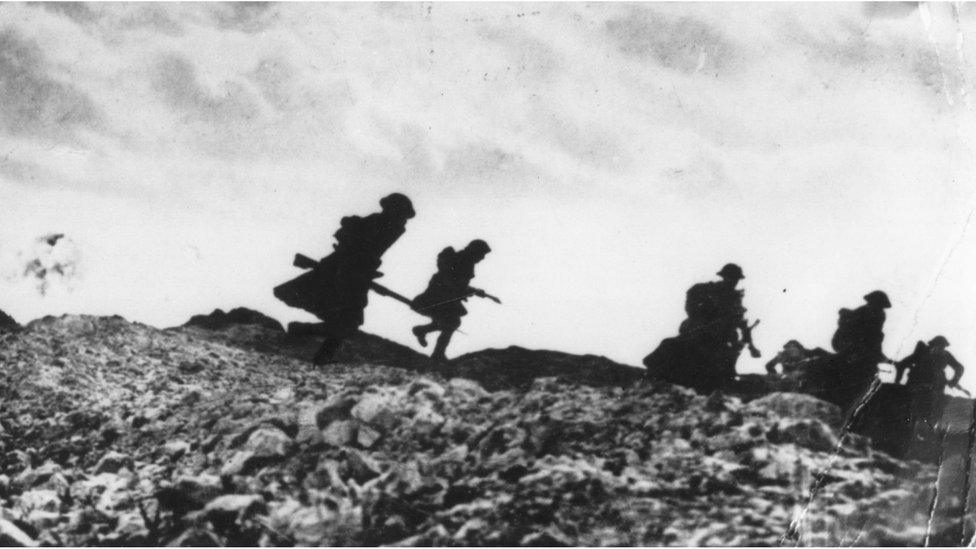
British troops faced machine gun, rifle and artillery fire as they moved across no-man's land during the Battle of the Somme
Commemorations
For northern Protestant unionists, the sacrifice on French fields was seen as a price paid to ensure that Ulster would remain British.
Demands were made of the British government and those demands were eventually met - six of Ulster's nine counties remained in the United Kingdom when Ireland was partitioned in 1922.
For its part, nationalism had some idea of 'blood sacrifice' too - Ireland had bled for Britain, and was deserving of her freedom.
But the drive for self-determination had been split by the war.
Indeed, nationalists had fought for Britain in 1916, while others had rebelled against the crown's forces in the Easter Rising of that year.
Some men managed to do both. Like Emmet Dalton - a winner of the Military Cross in 1916; an IRA man during the Irish War of Independence by 1919; and subsequently a Major General in the Irish Free State's National Army in 1922.
As time went on, the 36th Ulster Division passed into unionist lore and was commemorated on memorials and on Orange banners.
There were marches in its honour, and murals are still visible in Belfast.
As Northern Ireland descended into the civil unrest in the 1960s which would evolve into the Troubles, a newly formed paramilitary group took the name of the Ulster Volunteer Force.
It was a deliberate move to evoke memories of those volunteers from 50 years previous who had defended Ulster from Home Rule.
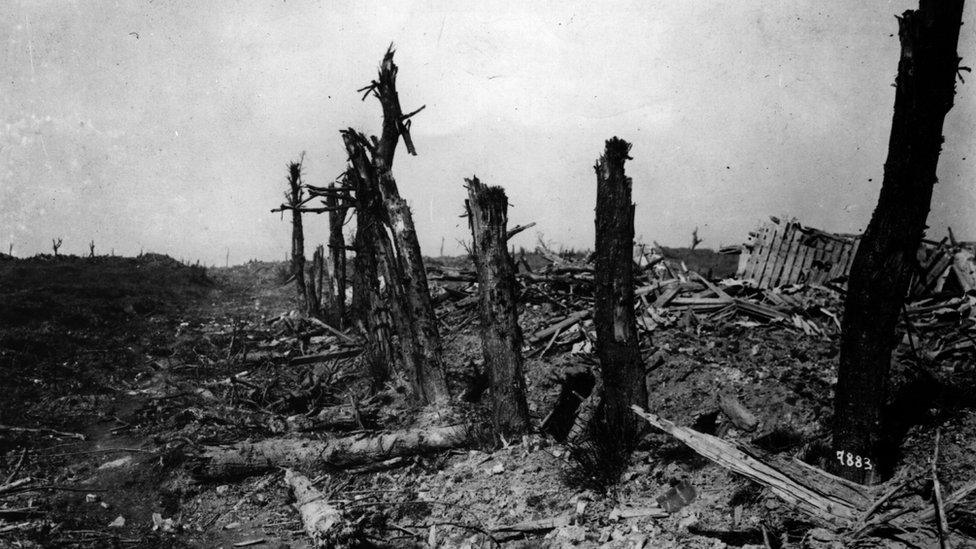
The Battle of the Somme was the site of one of the largest military bombardments of the First World War
To the south, the memory of the 16th Irish Division was initially preserved, even after Ireland's partition. Thousands attended Armistice Day events in Dublin in the 1920s.
Gradually, however, the stature of those Irishmen who fought for the British in the First World War was eroded.
Republicans spoke out against the 'Poppy Day' parades and there were incidents of violence at events in the 1930s.
When the Second World War broke out the 'Poppy Day' parades were banned to ensure Irish neutrality.
They resumed after the war, but the Irish Free State became a republic in 1949 and the soldiers who had died for king and empire were airbrushed from national memory.
However, in recent years, that circle has turned.
Now, there is recognition of the loss suffered by Irish families in the First World War - regardless of politics or religion.
On both sides of the border, in this centenary year, those from Ireland who fell during one of warfare's most bloody battles, will be remembered.